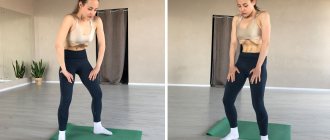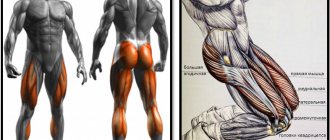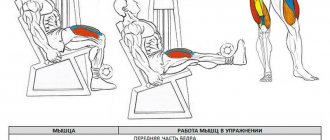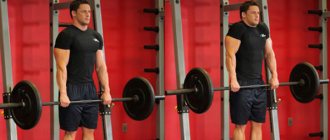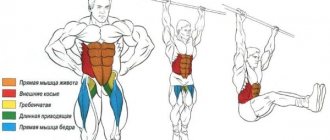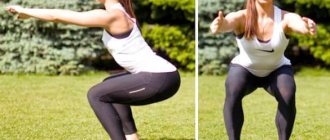The “Vacuum” exercise came into modern fitness from yoga. He is credited with the effects of healing, losing weight, increasing skin elasticity and others. Many trainers present it as universal and recommend it to everyone, but is this true?
Let's figure out what you can expect from a vacuum, how to do it correctly and what contraindications there are.
They say that a vacuum will make your abs sculpted and strong. But is it?
What happens during a vacuum run?
Vacuum is an exercise that trains the inspiratory muscles and gently massages the gastrointestinal tract.
The mechanics of the exercise are as follows. After a smooth and deep inhalation, a full exhalation and breath holding follow. At this time, a “false inhalation” occurs: the diaphragm relaxes and retracts upward, the pressure in the abdominal cavity drops. As a result, the abdominal organs are also pulled up, and venous outflow improves.
The vacuum activates the parasympathetic nervous system, and therefore the digestive system: blood flow to the gastrointestinal tract increases, digestion processes and intestinal motility are stimulated.
Benefits for the body
Since the “vacuum” exercise for the abdomen originally came from yoga, where they think not only about the physical perfection of a person, it is obvious that it can give a lot to health. First of all, during the execution the internal organs are massaged, and this is very useful in itself. In addition, all cells of the body are saturated with oxygen. And:
Read also: What to do if you gain weight while losing weight?
- Posture improves and existing back discomfort decreases;
- Digestive processes are normalized, including intestinal function;
- Blood circulation of internal organs is stimulated;
- Congestion in the pelvic organs is prevented;
- There is a calming effect and filling with vigor.
In addition, one can note the undoubted psychological benefit of the “vacuum” - due to obvious external changes, self-confidence appears, the outlook and mood change. And for men, their shoulders actually and psychologically straighten, because the exercise visually expands the chest and, as noted above, affects the posture itself.
What effects can be expected and what will not happen?
The vacuum can help tighten the belly and improve digestion.
However, people react differently to the exercise. Some people report feeling more alert or relieved from bloating. Others are discomfort and unpleasant sensations before and after execution. In case of discomfort, there is no need to perform the exercise.
A vacuum will not help you lose weight, get ripped abs, or cure diseases. But, like other exercises, it has its own beneficial effects, which is why it is popular in training programs.
Abdominal vacuum for beginners
The abdominal tuck exercise is known as the “vacuum”. And he is greatly adored by the “phytonies”! It is considered effective for weight loss. You, too, can use the practice of Alexey Mamatov to lose belly fat.
Abdominal vacuum - what muscles work:
- unloading the spine,
- improved digestion,
- massage of internal organs under and above the diaphragm (liver, pancreas, stomach, heart).
Some people observe that the pressure is equalized, the kidneys are tightened, and the blood vessels are freed.
The most important thing is that retracting the abdomen revitalizes the abdominal lymphatic duct. Lymph is cleansed. And as a result, the immune system is launched.
If the exercise is performed correctly, the capillary bed opens. The smallest vessels awaken not only in the tips of the fingers and toes, but also in the internal organs. Any infection is eliminated from the body as quickly as possible.
Vacuum technique
According to the classical technique, the vacuum is performed with a relaxed stomach and on an empty stomach.
All work occurs through breathing. If you feel your stomach tightening during the exercise, check your technique.
How to make a vacuum correctly
Brief instructions: choose a comfortable position for the exercise, straighten your back and straighten your spine, take a “false breath”, stay in this position until discomfort sets in, return to the starting position and take a new breath.
Step 1. Choose a starting position: lying on your back, standing on four points of support or standing with your palms resting on your knees
In the starting position, it is important to straighten your back and stretch your spine well. Imagine that you are being pulled in different directions by the crown and tailbone.
A straight spine and correct posture will do half the work for you. When the pelvis is aligned with the chest and the chest is pushed forward, this in itself tightens the stomach. So, with a “false inhalation,” it becomes easier to draw it in.
It is most convenient to do a vacuum from a lying position or standing with your palms resting on your knees. In the first case, gravity helps to “sink” the stomach, and in the second, it helps to stretch the spine.
Vacuum exercise with palms resting on knees
Step 2: Take a false breath
Take a comfortable breath and exhale deeply so that your stomach tightens and there is no air left in your lungs. Imagine that a damper was placed between the collarbones, which prevents air from entering the lungs. Spread your ribs as if you were inhaling - this is a “false inhalation.”
As a result of false inhalation, the pressure in the chest area drops and the diaphragm is pulled up. Following the diaphragm, the abdominal organs and deep abdominal muscles are tightened: the transverse muscle and the pelvic diaphragm.
In the classical technique, vacuum is performed without tension of the rectus and oblique abdominal muscles. This feature allows you to check whether you are doing the exercise correctly. If everything is technically correct, the stomach remains soft even in a retracted state, there is no tension or burning in the abdominal muscles.
Step 3. Hold the “false inhalation” with your stomach tucked in until you can comfortably hold your breath.
When you want to inhale, first relax your chest so that your stomach returns to its normal position. Only then take a breath.
If there are no contraindications, you can perform the vacuum daily for two weeks for 5 minutes. Then take a break for 1-2 weeks.
Vacuum exercise: what will be the results?
What will you get if you learn how to do a stomach vacuum correctly:
1 narrow waist and flat stomach (without pumped abdominal muscles)
2 will tighten the lower abdomen
3 good posture
4 burning visceral fat (this is the “internal” fat that is dangerous to health, which accumulates around the internal organs)
5 it becomes easier to “hold” your stomach
6 prevention and reduction of lower back pain
All the results you get from the abdominal vacuum exercise will be due to the fact that you strengthen the transverse muscle.
Contraindications
- Hernia of the anterior abdominal wall (umbilical, inguinal, white line of the abdomen) or diaphragm
- Diastasis (except physiological up to 1–2 cm)
Why you can’t do a vacuum with these contraindications. During a vacuum, intra-abdominal pressure decreases and the abdominal organs move. Therefore, performing the exercise with hernias of the anterior abdominal wall or diaphragm and a serious degree of diastasis can be dangerous due to the risk of strangulation of the hernia.
With diastasis, the likelihood of an increase in the discrepancy of the white line of the abdomen and the occurrence of a hernia also increases. It is possible to make a vacuum for diastasis if the discrepancy is within the physiological norm, that is, up to 2 cm.
- Kidney diseases (exacerbation of inflammatory diseases, nephroptosis 2 and 3 degrees)
- Inflammatory diseases in the acute stage (including diseases of the gastrointestinal tract, pelvic organs)
Why you can’t do a vacuum with these contraindications Activation of blood circulation in the abdominal organs and their displacement during the “false inhalation” phase can lead to increased inflammation and worsening of the condition in existing inflammatory diseases of the gastrointestinal tract, kidneys, and pelvic organs.
- Cardiovascular diseases (heart rhythm disturbances, acute myocardial infarction, history of aneurysm and pulmonary embolism, hypertension)
Why is it impossible to do a vacuum with these contraindications? The need to hold your breath for a long period of time (at this time the natural course of blood gas exchange changes), activation of venous outflow (venous blood enters the heart faster), an increase in blood pressure during exercise can provoke a deterioration in the condition of existing diseases of the cardiovascular system or a tendency to them.
- Pregnancy
Why you can’t do a vacuum with these contraindications Displacement of the abdominal organs, decreased pressure in the abdominal cavity and increased blood circulation can lead to pathological tone of the uterus and threats to the course of pregnancy.
The list of contraindications is informational and not exhaustive. If you have a disease or condition that makes you unsure whether or not to exercise, consult your healthcare professional.
Authors: Daria Knyazeva, group program instructor, postpartum recovery specialist, trainer-methodologist at the School of the Ideal Body #sekta; Anna Nesterova, head of scientific information and training at the School of the Ideal Body #sekta
Common Mistakes
Despite the simplicity of the “vacuum”, beginners can easily make inaccuracies in its implementation, which, although it will not cause harm, will not lead to the desired results. This:
- Lack of rest between approaches - the muscles (and the abdomen, in general) need to not only tense, but also be sure to relax. Therefore, between approaches in a “vacuum” you must take several measured inhalations and exhalations.
- A full stomach - many people think that this is not an essential condition, although there will be no benefit from doing this exercise, but there will be heaviness inside.
- Refusal to continue exercising if dizzy - at the initial stage, when the body has not developed the habit of a regular lack of oxygen, some discomfort is normal. As you repeat, the dizziness will go away.
It is worth remembering that if the “vacuum” leads to stabbing and cutting pain inside the abdomen, you should stop the exercise immediately. If this happens, then we are talking about either an incorrectly performed technique or the presence of contraindications. In both cases, you need to stop and find the mistake or abandon the exercise.
Regular (and no other) practice of “vacuum” will lead to noticeable results in the coming months - several centimeters will be lost from the waist.
Who is a vacuum suitable for?
The exercise is universal, suitable for both women and men, regardless of age. It should not be done during pregnancy, regardless of the period, or in elderly people with hypertension. Otherwise, there are no strict age restrictions; you just need to exclude contraindications.
Interestingly, vacuum is recognized as one of the best ways to train for women over 50 who have never exercised before. Isometric muscle contraction occurs painlessly, does not require preparation, and the effect will not take long to appear.
Men are recommended to perform the breathing technique not only for a flat and toned stomach, but also to improve digestion, since during the tension of the transverse muscle, a kind of abdominal massage occurs, which has a positive effect on the production of digestive enzymes.
Vacuum Breathing Options
Option No. 1 – lying down
1. Lie on your back, straighten your shoulders, “stick” your lower back to the floor. Hands along the body, legs slightly bent at the knees. Inhale, then exhale (complete relaxation). There should be as much air as possible out of the lungs.
2. In this case, the stomach must be pulled inward as much as possible. Hold your breath.
For 15 seconds, you should fix the position of your stomach at the lowest point, taking a slightly noticeable breath, you can continue to draw in your stomach.
3. After a weak sigh, you should not rush to relax. You will need to tense your stomach and “freeze” for 10 seconds, then pull your stomach in again, keeping your abdominal muscles tense.
If it is difficult to hold your breath, you can take small breaths.
4. As you exhale, relax your stomach. Afterwards, breathe in a couple more times, exhale and again begin to empty the lungs of air, drawing in the stomach as much as possible (the muscles are tense). Then, without inhaling, “push” your stomach upward.
By making a vacuum, you can specifically strengthen the internal abdominal muscles. After just 6-7 days, your waist size will decrease and your overall figure will improve.
Option number 2 - standing
1. Place your feet shoulder-width apart, your back straight, your hands on your hips.
2. Inhale deeply through your nose (suck in as much air as possible).
3. Exhale sharply through your mouth. Pushing out all the air, parallel pull your stomach towards your spine.
4. Hold your breath for 5-40 seconds (depending on the level of training).
While performing the exercise, you can rest your hands on some surface (window sill, table, etc.) or on your bent knees.
Option number 3 - sitting on a chair
1. The back is as straight as possible and at the same time relaxed. Place your hands on your knees. Bend your head parallel to the floor.
2. Take a deep breath through the nose (the stomach inflates), and through the mouth – a long exhale.
3. Pull in your stomach as much as possible.
Vacuum in a sitting position is done in the same way as in a standing position.
Option number 4 - on all fours
1. Get on all fours, align your back - parallel to the floor. Place your hands under the shoulder joints. Place your knees under your hip joints.
2. When inhaling through the nose, bend your back down.
3. As you exhale through your mouth, round your back, lower your head down and press it to your chest, spread your shoulder blades.
The abdominal vacuum on all fours has an active effect on the back muscles, strengthening them.
How does a vacuum work?
During execution, the transverse abdominal muscle is activated. It contracts when you hold your breath and remains tense for a certain time. The strong transverse muscle acts as a kind of corset for the entire abdominal and lumbar region. The presence of a strong corset creates a narrow waist.
The method has one significant drawback - breathing exercises do not burn fat at all, so if you are overweight, they are completely useless. Anyone can perform a vacuum, but to achieve results you will have to do cardio and review your diet.
